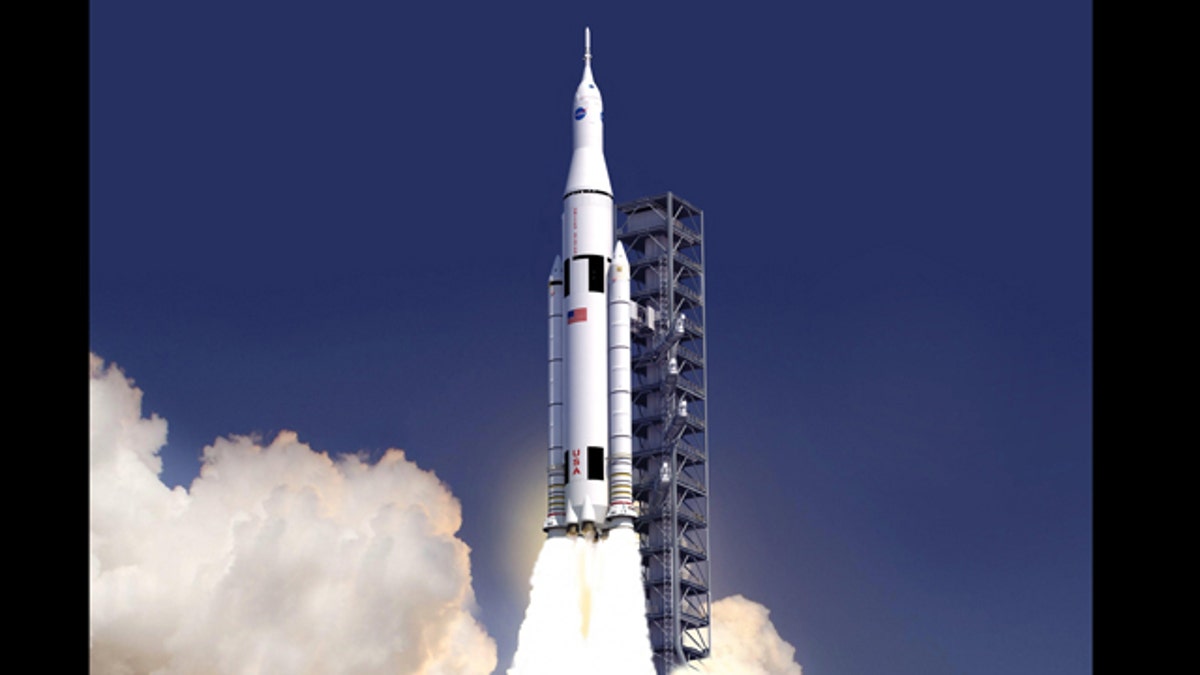
Artist concept of SLS launching. (NASA)
Deep space, here we come!
NASA announced the design for its next-generation rocket Wednesday morning, a potentially $35 billion vehicle called the Space Launch System (SLS) that the space agency believes can replace the space shuttle and power the future of American space flight.
"The next chapter of America's space exploration program is being written today," NASA administrator Charles Bolden said in a joint news conference at the Senate.
The design for NASA's newest behemoth of a rocket harkens back to the giant workhorse liquid-fueled rockets that propelled men to the moon. But this time, destinations will be much farther and the rocket -- which will carry astronauts in a capsule called Orion and will start test launching by 2017 -- will be even more powerful.
"The long term goal has to be what's out there that we haven't explored yet," said Senator Kay Hutchison (R-Tex.), ranking member of the Senate Commerce, Science and Transportation Committee.
The size, shape and heavier reliance on liquid fuel as opposed to solid rocket boosters is much closer to Apollo than the recently retired space shuttles, which were winged, reusable ships that sat on top of a giant liquid fuel tank, but needed twin solid rocket boosters for most of their power. It's also a shift in emphasis from the moon-based, solid-rocket-oriented plans proposed by the George W. Bush administration.
"It's back to the future with a reliable liquid technology," said Stanford University professor Scott Hubbard, a former NASA senior manager who was on the board that investigated the 2003 space shuttle Columbia accident.
NASA figures it will be building and launching about one rocket a year for about 15 years or more in the 2020s and 2030s.
The idea is to launch its first unmanned test flight in 2017 with the first crew flying in 2021 and astronauts heading to a nearby asteroid in 2025, officials told the Associated Press. From there, NASA hopes to send the rocket and astronauts to Mars -- at first just to circle, but then later landing on the red planet -- in the 2030s.
Initially the rockets will be able to carry into space 70 tons to 100 tons of payload, NASA said, which would include the six-person Orion Multi-Purpose Crew Vehicle capsule and more. Eventually it will be able to carry 143 tons into space, maybe even 165 tons, officials told the Associated Press. By comparison, the long-dormant Saturn V booster that sent men to the moon was able to lift 130 tons.
The plans dwarf the rumbling lift-off power of the space shuttle, which could haul just 27 tons. The biggest current unmanned rocket can carry about 25 tons.
The size of the plans elicited an amazed "good grief" from Hubbard, who said it would limit how often they could be built or launched. Unlike the reusable shuttle, these rockets are mostly one-and-done, with new ones built for every launch.
Some of the design elements, the deadline and the requirement for such a rocket were dictated by Congress.
While the recently retired space shuttle's main engines were fueled by liquid hydrogen and liquid oxygen, it was primarily powered into orbit by solid rockets. Solid rocket boosters were designed to be cheaper, but a booster flaw caused the fatal space shuttle Challenger accident in 1986. The biggest drawback was that solid rockets can't be stopped once they are lit; liquid ones can.
The new plan is to use a giant rocket powered by liquid hydrogen and liquid oxygen. Apollo, Gemini and Mercury flew into space on liquid rockets, and liquids fuel most of the world's unmanned commercial rockets. Russia's Soyuz rocket is liquid fueled too.
During its initial test flights the rocket will use five solid rocket boosters designed for the shuttle strapped on its outside and will have shuttle main engines powering it on the inside. But soon after that the solid rocket boosters will be replaced with new boosters that should have new technology and may be either liquid or solid, the officials said
NASA figures it will spend about $3 billion a year on the plan, officials told the Associated Press. The key financial part of this arrangement is that NASA hopes to save money by turning over the launching of astronauts to the International Space Station, which orbits the Earth, to private companies and just rent spaces for astronauts like a giant taxi service. NASA would then spend the money on leaving Earth's orbit and the Earth-moon system.
Hubbard worries that NASA has a history of spending way more than initially proposed -- the space shuttle cost about twice what it was supposed to -- and this new rocket system will drain money from other NASA missions.
And the cost of the program is just one issue that remains unclear. Senator Bill Nelson, chairman of the Science and Space Subcommittee, puts the cost of the program at about $18 billion over the next five years -- or $3 billion a year. Some estimates, however, are closer to $35 billion.
NASA hopes to save money by turning over the launching of astronauts to the International Space Station, which orbits the Earth, to private companies and just rent spaces for astronauts like a giant taxi service. NASA would then spend the money on leaving Earth's orbit and the Earth-moon system.
Nelson argued that if we continued steady spending, the project would be successfully funded.
"In the bosom of every American there is a yearning for us to explore the heavens," he said.
The Associated Press contributed to this report.




















